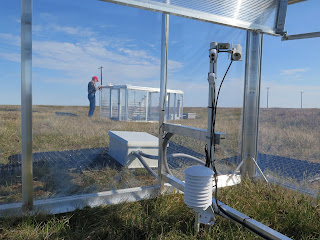A primary goal of Ecosystem and Earth System Models is to
project the impact of future global change scenarios. Those projections
are often dependent on model assumptions about how ecosystems respond to novel
climates. Experimental manipulations provide an opportunity to test those
model assumptions and provide new information to improve model skill.
The Arctic is projected to warm by 5-11°C over the next hundred years.
Understanding how plant structural and functional traits respond to projected
temperature change is a critical uncertainty in Arctic systems but evaluating model assumptions is challenging in a system where access to reliable line
power and operational constraints rule out many approaches. Passive warming has a long history in the
Arctic but this approach is only able to elevate air temperature by 1-2°C. At Brookhaven National Laboratory Keith Lewin
developed a novel approach to elevate and modulate the temperature inside field
enclosures and achieve markedly higher passive elevation and control of temperature. Zero power warming (ZPW) uses solar energy to warm
the enclosure and heat exchangers inside and outside the chamber to modulate temperature and prevent overheating.
Our Long Island prototype performed well and we were keen to evaluate
the approach in Barrow. As part of our
2015 NGEE Arctic field season we are testing Keith’s design on the BEO.
Over the past week Keith, Andrew McMahon and I have worked to
install a ZPW chamber and a vented control chamber, near the
sled shed on Cake Eater Road. Keith
assembled the chambers at Brookhaven then packed them up and shipped them to
Barrow where we rebuilt them. Yesterday we
completed the build and the first day of data looks very promising.
Compared to the vented control chamber the ZPW chamber was able to
elevate and modulate air temperature. This is exciting data for day one of operation
and a nice treat for July 4th.
See the day-by-day progress on our twitter feed @bnl_test


